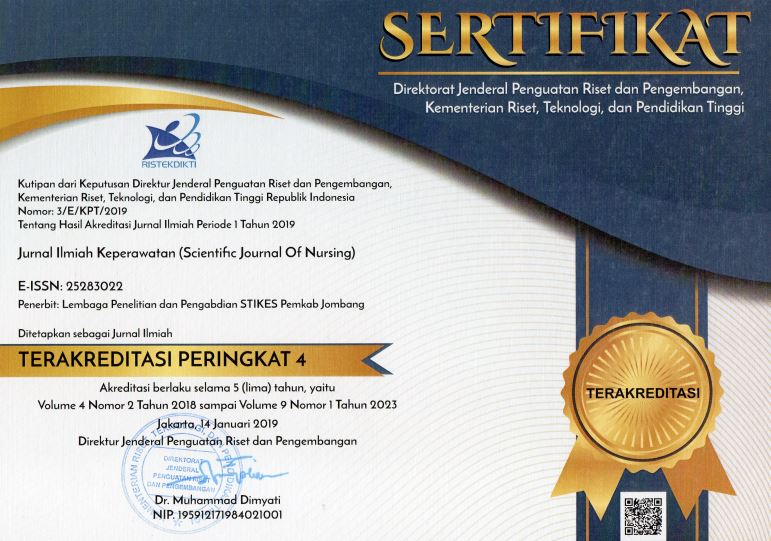STUDI DESKRIPTIF MOTORIK KASAR ANAK CEREBRAL PALSY
Descriptive Study of Gross Motor Ability in Children with Cerebral Palsy
DOI:
https://doi.org/10.33023/jikep.v9i1.1397Keywords:
cerebral palsy, gross motor, whatsapp group communityAbstract
Pendahuluan : Cerebral palsy merupakan permasalahan perkembangan otak pada masa tumbuh kembang. Kelainan ini akan mengakibatkan keterlambatan perkembangan motorik kasar. Motorik kasar adalah kemampuan anak untuk bergerak melawan gravitasi seperti posisi kelurusan kepada dan badan, gerakan berguling, duduk, merangkak hingga berdiri dan berjalan. Tujuan: Penelitian ini bertujuan untuk mengetahui gambaran kemampuan gerak motorik kasar anak cerebral palsy yang tergabung pada komunitas WA Grup cerebral palsy di beberapa kota di Indonesia. Metode: Penelitian ini merupakan penelitian observasional deskriptif. Penelitian dilakukan di beberapa komunitas WA Grup di Indonesia (Sumatera, Jawa, Kalimantan, Sulawesi, dan Nusa Tenggara). Hasil: Dari 136 responden orang tua anak cerebral palsy, didapatkan data rerata usia anak CP adalah 5.4 tahun, jenis kelamin laki-laki (53%) dan perempuan (47%), tipe CP terbanyak adalah spastic quadriplegia (26%), 76% mengalami asimetri kepala dan badan, 43% belum bisa tengkurap-terlentang, 53% belum bisa duduk, 68% belum bisa merangkak, 65% belum bisa berdiri, 76% belum bisa berjalan. Kesimpulan: Sebagian besar anak pada penelitian ini mengalami CP tipe berat/quadriplegia dengan asimetri kepala sehingga mengakibatkan perkembangan motorik kasar tidak sesuai dengan fase dan usianya. Untuk langkah selanjutnya perlu diberikan edukasi fisioterapi berupa latihan orientasi tengah tubuh dan kepala, berguling, duduk, merangkak hingga berjalan untuk mengejar ketertinggalan motorik kasar pada subyek
Downloads
References
Bushra Abdul Malik* Sadia Zafar* Abdul RazzaqMuhammad Asghar Butt, M. S. (2007). Frequently Associated Problems of Cerebral Palsy . 1(2).
Cankurtaran, Damla (2021) An investigation into the factors which affect the sitting balance of non-ambulatory children with cerebral palsy, Neurology Asia 26(3): 575-583
Casteli, Enrico E. F. (2016). Recommendations for the rehabilitation of children with cerebral palsy. 52(5).
Clutterbuck G, Auld M, Johnston L (2019). Active exercise interventions improve gross motor function of ambulant/semi-ambulant children with cerebral palsy: a systematic review. Disabil Rehabil. 2019 May;41(10):1131-1151. doi: 10.1080/09638288.2017.1422035. Epub 2018 Jan 5. PMID: 29303007.
Fogel. (2012). Childhood cerebellar ataxia. J Child Neurol, 1138.
Himmelmann, E. B. (2006). Gross and fine motor function and accompanying impairments in cerebral palsy. 48(6).
Hong, J. S. (2017). New Ideas of Treatment for Cerebral Palsy I Capital. 5.
Ilharreborde, B., Etienne, S., Presedo, A., & Simon, L. (2020). Spinal sagittal alignment and head control in patients with cerebral palsy. Journal of Children's Orthopaedics, 14(1), 17-23. https://doi.org/10.1302/1863-2548.14.190160
Karande S, Patil S, Kulkarni M (2022). Impact of an educational program on parental knowledge of cerebral palsy. Indian J Pediatr. 2008 Sep;75(9):901-6. doi: 10.1007/s12098-008-0160-0. Epub 2008 Sep 22. PMID: 18810366.
Kemenkes RI (2016). PEDOMAN PELAKSANAAN Stimulasi, deteksi dini dan intervensi dini tumbuh kembang anak di tingkat pelayanan kesehatan dasar.
Kobesova, A. (2014). Developmental kinesiology: Three levels of motor control in the assessment and treatment of the motor system. Journal of Bodywork and Movement Therapies, 23-33.
Lisnaini. (2021). Fisioterapi Pediatri Neuromuskuler dan Genetik. Jakarta: UKI Press.
MacLennan AH, Thompson SC, Gecz J (2015). Cerebral palsy: causes, pathways, and the role of genetic variants. Am J Obstet Gynecol. 2015 Dec;213(6):779-88. doi: 10.1016/j.ajog.2015.05.034. Epub 2015 May 21. PMID: 26003063.
Mathewson, M. a. (2015). Pathophysiology of Muscle Contractures in Cerebral Palsy. . America: Physical Medicine and Rehabilitation Clinics of North America,.
Oskoui M, et al (2013). The relationship between gross motor function and manual ability in cerebral palsy. J Child Neurol. 2013 Dec;28(12):1646-52. doi: 10.1177/0883073812463608. Epub 2012 Oct 30. PMID: 23112248.
Pin, Tamis et al (2019), Relationship between segmental trunk control and gross motor development in typically developing infants aged from 4 to 12 months: a pilot study., BMC Pediatrics (2019) 19:425 https://doi.org/10.1186/s12887-019-1791-1
Robinson, M. (2008). Child development 0-8 : a journey through the early years. Berkshire ; New York : McGraw-Hill Education.
Sugiyono (2016). Metode Penelitian kualitatif dan kuantitatif. Bandung: Alfabeta Bandung.
Ugorji, T. e. (2019). The Effect of Gender, Age and Cerebral Palsy Sub-Type on The Prevalence of Specific Gait Deviations in Cerebral Palsy Children. . Current Trends in Biomedical Engineering & Biosciences.
Vitrikas, Kirsten et al (2020), Cerebral palsy an overview, Am Fam Physician. 2020 Feb 15;101(4):213-220. PMID: 32053326.
o the factors which affect the
sitting balance of non-ambulatory children with
cerebral palsy
Damla Cankurtaran MD, Nihan Abidin MD, Ece Unlu Akyuz MD, Nihal Tezel MD
Published
How to Cite
Issue
Section
Authors who publish with Jurnal Ilmiah Keperawatan (Scientific Journal of Nursing) agree to the following terms:
- Authors retain copyright and grant Jurnal Ilmiah Keperawatan (Scientific Journal of Nursing) the right of first publication with the work simultaneously licensed under a Creative Commons Attribution 4.0 International License that allows others to remix, adapt and build upon the work with an acknowledgment of the work's authorship and of the initial publication in Jurnal Ilmiah Keperawatan (Scientific Journal of Nursing).
- Authors are permitted to copy and redistribute the journal's published version of the work (e.g., post it to an institutional repository or publish it in a book), with an acknowledgment of its initial publication in Jurnal Ilmiah Keperawatan (Scientific Journal of Nursing).









